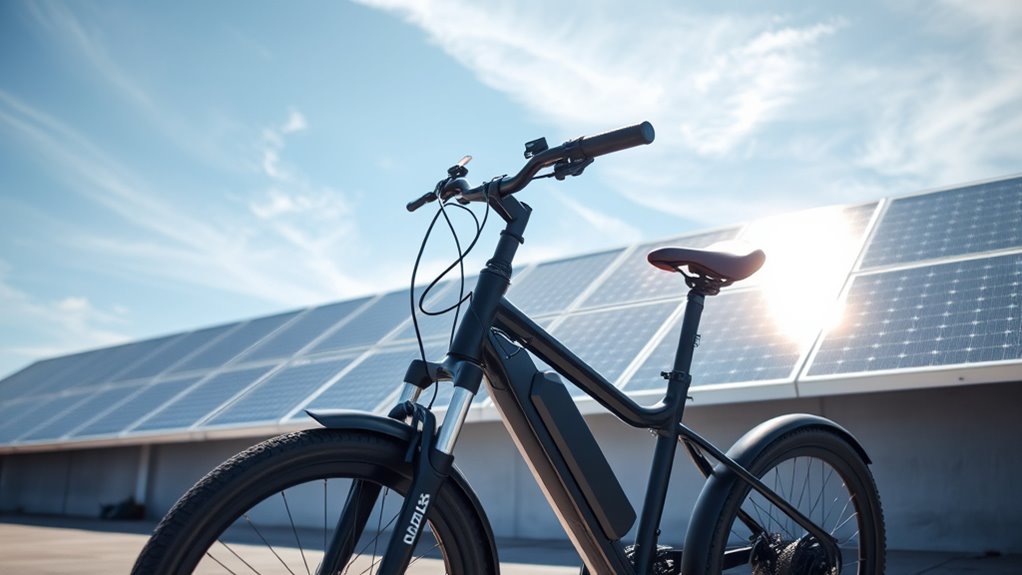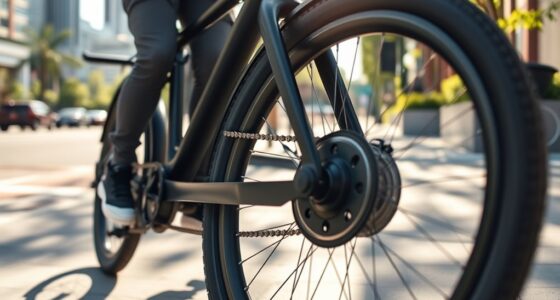To charge your e-bike with solar panels, select durable, monocrystalline or polycrystalline panels that fit your space and energy needs. Install them in a sunny, unobstructed location with weatherproof mounts, ensuring proper wiring and compatibility with your battery. Keep panels clean and check connections regularly for maximum efficiency and safety. Proper setup and maintenance help extend system lifespan and optimize performance—if you want to learn more about creating an effective solar charging station, keep exploring these steps.
Key Takeaways
- Select compatible solar panels with suitable voltage and current for your e-bike’s battery specifications.
- Install panels in a location with maximum sun exposure and minimal shading for optimal charging.
- Use weatherproof mounts and proper wiring to ensure safe, durable outdoor setup.
- Connect panels to a compatible charge controller to manage power transfer and prevent overcharging.
- Regularly clean panels and inspect connections to maintain efficiency and prolong system lifespan.
Understanding Solar Panel Basics for E-Bike Charging
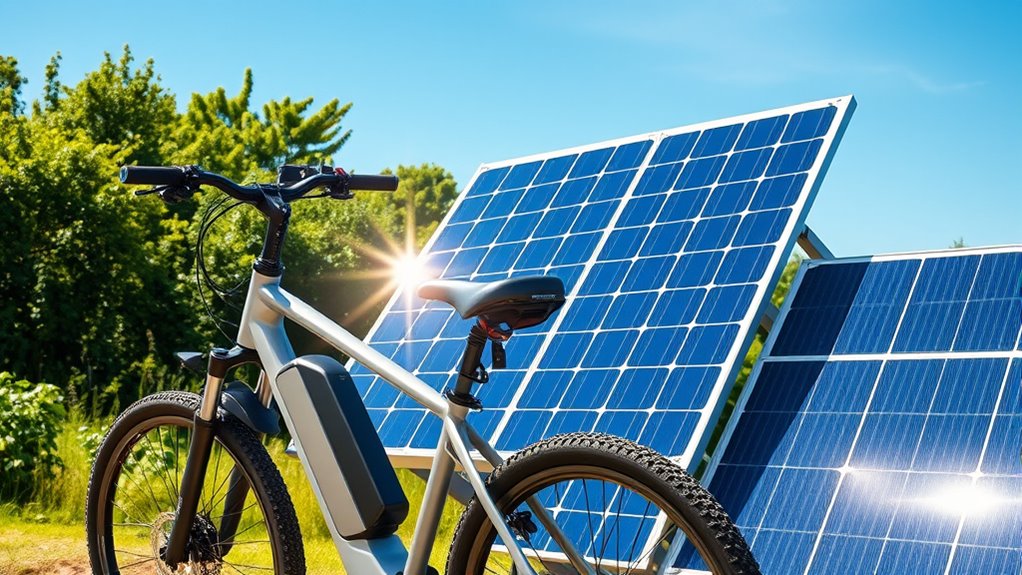
To effectively charge your e-bike with solar panels, it’s essential to understand the basics of how these panels work. Solar panel materials, such as silicon, determine the efficiency and durability of your system. Monocrystalline panels tend to be more efficient, making them suitable for limited space, while polycrystalline panels are more affordable but slightly less efficient. Additionally, guaranteeing battery compatibility is vital; your solar system must deliver the correct voltage and current to match your e-bike’s battery specifications. This prevents damage and guarantees maximum charging. Recognizing how solar panel materials influence performance helps you select the right setup, and understanding battery compatibility ensures your e-bike charges safely and efficiently from solar energy.
Selecting the Right Solar Panel System for Your Needs
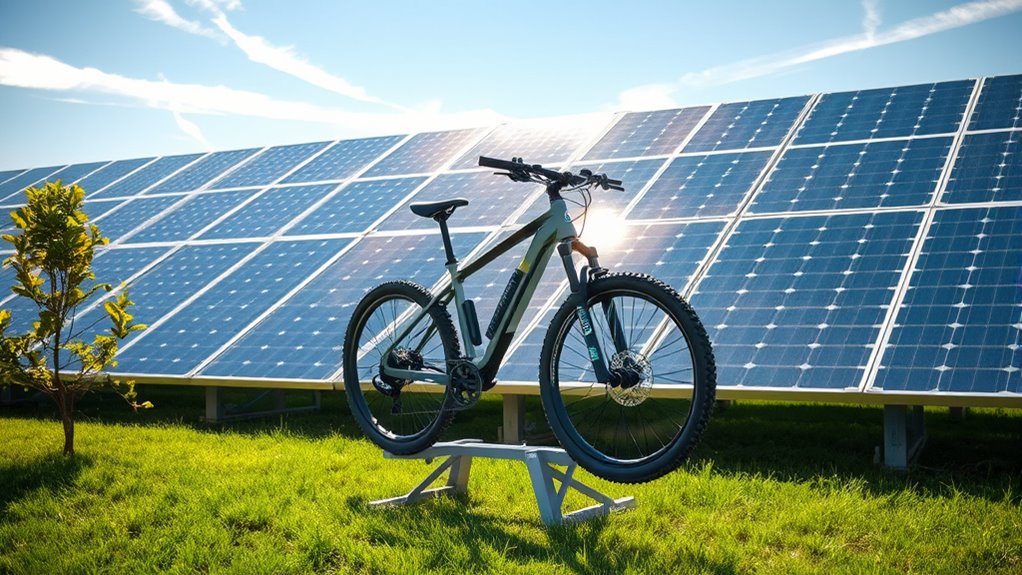
To choose the right solar panel system, you need to consider both efficiency and size to match your charging needs. Your budget also plays a key role in selecting options that balance cost with performance. By understanding these factors, you can find a system that fits your e-bike charging requirements and financial situation. Additionally, researching solar panel technology can help you select more reliable and effective options for your setup.
Panel Efficiency and Size
Choosing the right solar panel system hinges on understanding both panel efficiency and size. Higher efficiency panels convert more sunlight into electricity, which means you’ll generate more power even in limited space. This is especially useful if you have a small area for installation. Size matters because larger panels can produce more energy, but they require more space and may impact your setup’s aesthetics. Consider solar panel durability, as durable panels withstand weather conditions better and last longer, giving you reliable performance over time. Additionally, look into different panel mounting options to ensure secure installation that suits your environment. The right balance between efficiency and size ensures your solar setup is optimized for your energy needs while fitting comfortably with your available space. Understanding solar panel ratings can help you make more informed choices about your system’s overall performance and longevity.
Cost and Budget Considerations
When selecting a solar panel system for your e-bike, understanding the costs involved is essential to stay within your budget. Conducting a thorough cost analysis helps you compare options and determine what fits your financial plan. Consider not just the upfront price of panels, but also installation costs, inverter expenses, and potential maintenance. Budget planning allows you to allocate funds effectively and avoid surprises down the line. Smaller, cheaper panels might save money initially but could fall short of your energy needs, while larger systems cost more but provide faster charging. Balancing performance with affordability ensures you choose a system that meets your needs without overspending. Being mindful of these factors will help you make an informed decision that aligns with your budget. Additionally, understanding the cost efficiency of different panel sizes can guide you toward a system that offers the best value for your investment.
Setting Up Your Solar Charging Station

Now that you’ve selected your solar panels, it’s time to set up your charging station. You’ll need to find a suitable location, install the system securely, and connect your e-bike properly. Let’s walk through each step to guarantee your setup runs smoothly and efficiently. For optimal performance, consider the performance of your solar system and how it can be tailored to meet your energy needs.
Choosing Suitable Solar Panels
Selecting the right solar panels is essential to ensuring your e-bike charges efficiently. You want panels with solid warranties to protect your investment, especially if weather or shading impacts performance. Consider panel mounting options that suit your space—ground mounts, roof mounts, or portable setups—based on your setup needs. Look for panels with good efficiency ratings to maximize energy output in limited space. Additionally, choosing panels with easy maintenance can prolong their lifespan and ensure consistent performance over time.
Installing the Charging Station
Setting up your solar charging station involves determining the most suitable location, securing the necessary mounting hardware, and connecting your panels to a compatible charge controller. Choose a spot with maximum sun exposure and minimal shading, guaranteeing stability for your panels. Once mounted, connect your panels to a charge controller that manages power flow and protects your battery storage system. Incorporate battery storage to store excess energy for later use, increasing your station’s efficiency. If you plan on grid integration, ensure your system is compatible with local regulations and utility requirements. Proper wiring and grounding are essential for safety and peak performance. Additionally, consulting with a Smart Home expert can help optimize your setup for maximum efficiency and safety. This setup allows your solar panels to efficiently generate and store energy, ready for charging your e-bike anytime.
Connecting Your E‑Bike
To connect your e-bike to the solar charging station, start by turning off your bike and unplugging it from any existing power sources. Check your e-bike’s battery chemistry—whether lithium-ion or another type—as this affects charging compatibility and safety. Confirm your solar charger’s voltage and current match your bike’s specifications to prevent damage. When connecting, use the appropriate adapters and secure all connections tightly. Weather considerations matter too; avoid charging in rain or extreme temperatures to protect your bike and charger. Keep cables organized and protected from moisture or direct sunlight. Once everything’s properly connected, turn on the solar station, and monitor the initial charge to verify your e-bike charges safely and efficiently. Additionally, ensure your solar panels are positioned to maximize sunlight exposure for optimal charging performance and proper operation.
Connecting Solar Panels to Your E-Bike Battery
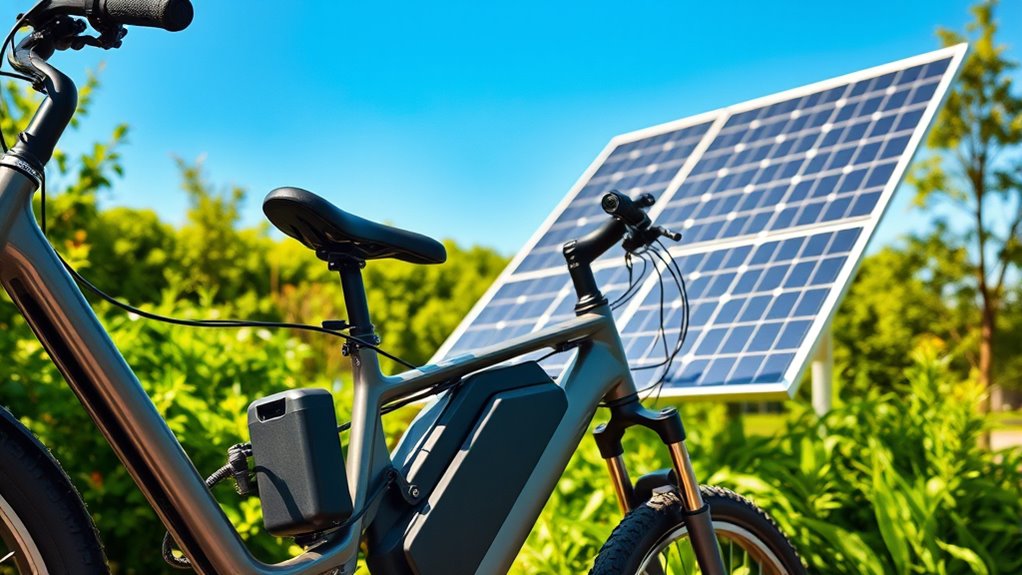
Connecting your solar panels to your e-bike battery requires careful attention to compatibility and proper wiring. First, check the solar panel’s durability to make sure it can withstand outdoor conditions without degrading quickly. Next, verify that the panel’s voltage and current output match your e-bike’s battery specifications to prevent damage. Use appropriate connectors and wiring to guarantee secure, corrosion-resistant connections. Avoid mismatched voltage levels, as they can cause overcharging or undercharging, reducing battery life. Always follow manufacturer guidelines for both the solar panel and battery, and consider adding a charge controller to regulate power flow. Additionally, understanding the self-watering plant pots can help you maintain proper hydration for your plants while they are charging. Properly connecting your solar panels ensures safe, efficient charging while protecting your e-bike’s battery from potential damage.
Tips for Maximizing Charging Efficiency

Maximizing your e-bike’s solar charging efficiency involves enhancing several key factors. First, regularly perform solar panel maintenance by keeping the surface clean and free of dust, dirt, and debris. This guarantees maximum sunlight absorption. When outdoor installing your panels, choose a location with direct sunlight exposure, ideally facing south if you’re in the Northern Hemisphere, and avoid shaded areas or obstructions. Angle the panels to match the sun’s position throughout the day for peak performance. Secure them firmly to withstand weather conditions. Additionally, monitor the panels for any damage or wear. Proper outdoor installation tips include using weatherproof mounts and avoiding reflective surfaces nearby that could reduce efficiency. Implementing organic techniques such as soil fertility management can also improve the overall health of your installation area, ensuring consistent performance and durability. These steps help you harness the sun’s power more effectively, ensuring your e-bike charges quickly and reliably.
Maintaining Your Solar Power System for Longevity
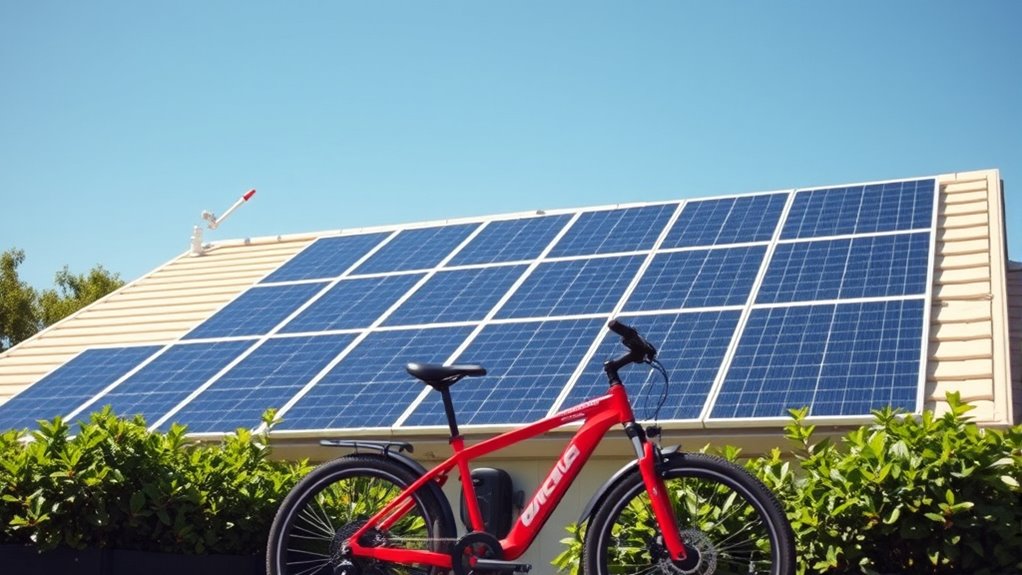
Regular maintenance is crucial to guarantee your solar power system remains efficient and lasts for years. You should routinely check your solar panel maintenance to ensure they’re clean and free of debris, which can reduce energy output. Keep an eye on any shading or dirt buildup, and gently clean the panels with a soft cloth or water if needed. Properly maintaining your system also involves monitoring your batteries, as battery longevity depends on avoiding extreme temperatures and overcharging. Regularly inspect connections and wiring for signs of wear or corrosion. Updating firmware or software when available keeps your system running smoothly. Additionally, understanding juice detox benefits and precautions can help you optimize your system’s performance and safety. By staying proactive with these maintenance tasks, you maximize energy production and extend the lifespan of both your solar panels and batteries.
Frequently Asked Questions
How Long Does a Full Solar Charge Typically Take for an E-Bike?
The charging time for your e-bike depends on the solar panel capacity and the bike’s battery size. Generally, with a typical solar panel setup, you can expect charging time estimates to range from 4 to 8 hours of sunlight. If your solar panel capacity is higher, it’ll charge faster. Keep in mind, weather and sunlight intensity also influence how quickly your e-bike gets fully charged.
Can I Charge My E-Bike Indoors Using Solar Panels?
You can definitely charge your e-bike indoors using solar panels, but it’s not as simple as plugging in a regular charger. Indoor charging with solar panels requires proper solar panel placement near windows or other light sources, and you’ll need an efficient inverter and battery system. Think of it as harnessing the sun’s power even inside — it’s like capturing sunlight in a bottle, making your e-bike truly eco-friendly.
What Are the Safety Precautions When Connecting Solar Panels to Batteries?
When connecting solar panels to batteries, you need to prioritize safety. Make certain proper electrical grounding to prevent shocks and protect equipment. Use overcurrent protection devices, like fuses or circuit breakers, to avoid damage from power surges. Always follow manufacturer guidelines and double-check connections before powering up. These precautions help keep your setup safe, efficient, and reliable, reducing risks of electrical faults or accidents.
How Do Weather Conditions Affect Solar Charging Efficiency?
Did you know that weather conditions can reduce solar charging efficiency by up to 80%? Cloud cover blocks sunlight, substantially decreasing power generation, while wind interference can cause stability issues with your panels. You might notice slower charging on cloudy, windy days, making it essential to plan for ideal weather. Protect your panels from extreme weather and position them for maximum sun exposure to keep your e-bike charged efficiently.
Are Portable Solar Panel Options Suitable for E-Bike Charging?
Portable panels can be a good choice for charging your e-bike, especially if you need flexibility and convenience. They’re usually lightweight and easy to set up, making them suitable for on-the-go use. However, you should check compatibility concerns, such as matching the panel’s output with your e-bike’s charging requirements. If you pick the right portable panels, you’ll enjoy eco-friendly charging wherever you ride.
Conclusion
Charging your e-bike with solar panels is like giving it a gust of fresh, green energy. With the right setup and a bit of care, you’ll enjoy clean, free power that keeps you moving without harming the planet. Think of it as turning sunlight into a personal power source — a bright idea that makes your ride more sustainable and your adventures brighter. Embrace solar charging and let the sun fuel your journey forward.
